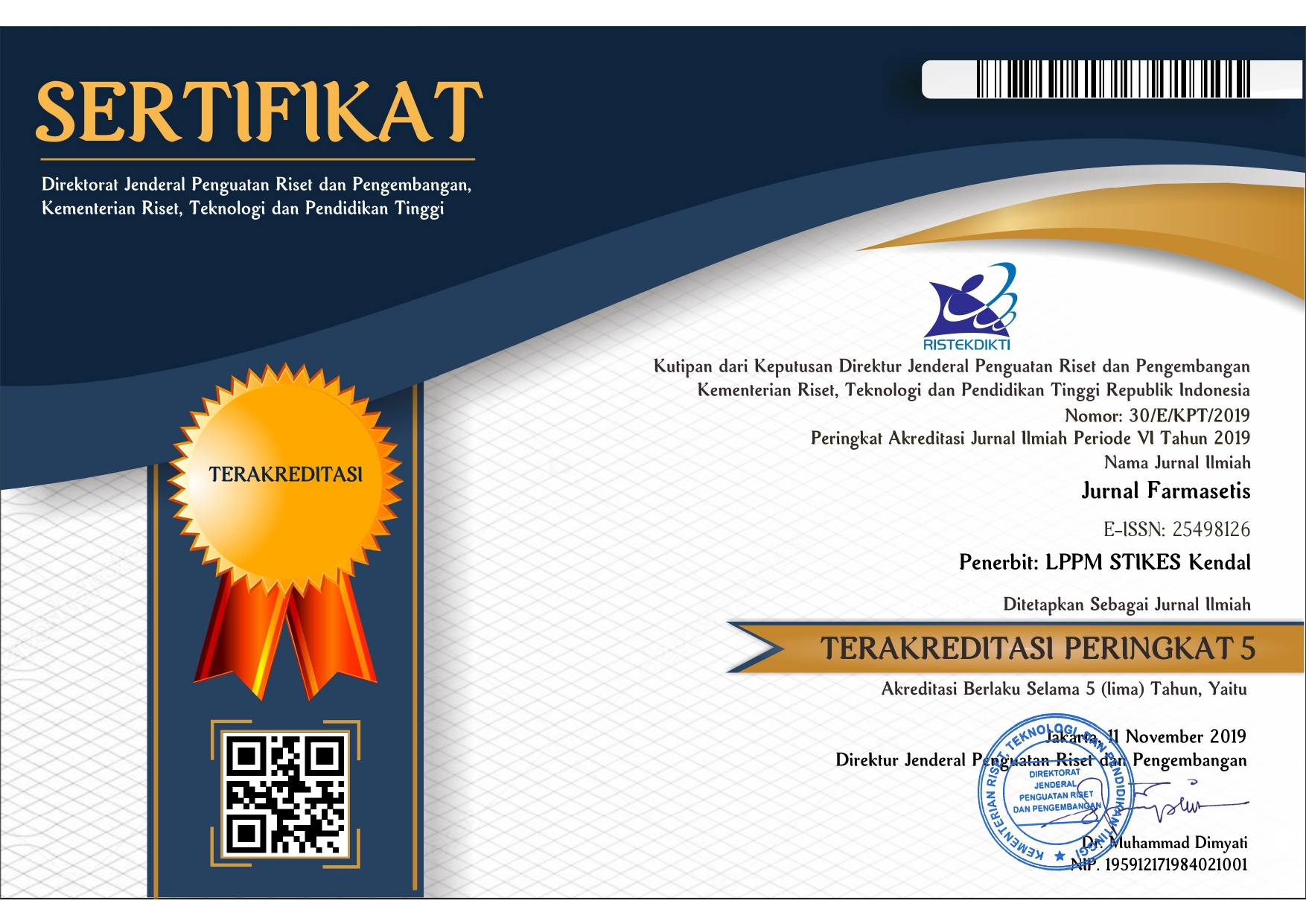Optimasi Komposisi Madu Kelulut (Trigona Sp) dan Minyak Zaitun (Olive Oil) dalam Salep
DOI:
https://doi.org/10.32583/far.v12i2.914Keywords:
Kelulut honey, olive oil, optimization, ointment, simplex lattice designAbstract
Madu kelulut (Trigona sp) dan minyak zaitun (Olive oil) telah lama diketahui memiliki potensi farmakologi dalam penyembuhan luka diabetes. Penelitian ini bertujuan untuk mengetahui komposisi optimum kedua bahan tersebut dalam sediaan salep. Tahap pertama orientasi kadar madu kelulut dan minyak zaitun (1:1) dalam salep dengan kadar 5%; 10%; 15%; 20%; 25% dan 30% berdasarkan parameter pH dan viskositas. Tahap kedua optimasi komposisi madu kelulut dan minyak zaitun dengan menggunakan aplikasi Design Expert 13® metode Simplex lattice design. Formula dievaluasi berdasarkan parameter pH, viskositas dan daya hambat bakteri menggunakan S.aureus ATCC 25923. Uji tahap pertama menunjukkan bahwa peningkatan konsentrasi bahan aktif menyebabkan penurunan pH dan viskositas. Hasil uji tahap kedua menunjukkan persamaan untuk parameter pH adalah Y=5,58965(A)+9,25632(B) 4,88017AB, viskositas adalah Y=11502,2552(A)+481,8706(B)+1,318x105AB dan daya hambat bakteri adalah Y=-4,148A+24,409B+15,947AB+72,654AB(A-B). Berdasarkan hasil penelitian diketahui konsentrasi optimum bahan aktif adalah 20% dengan komposisi optimum dari madu kelulut dan minyak zaitun pada perbandingan 0,586 dan 0,414.
References
Abd Jalil, M. A., Kasmuri, A. R., & Hadi, H. (2017). Stingless bee honey, the natural wound healer: A review. Skin Pharmacology and Physiology, 30(2), 66–75.
Ahmad, I., & Aqil, F. (2008). New strategies combating bacterial infection. John Wiley & Sons.
Anonim. (1996). SNI. 16-4399-1996 Sediaan Tabir Surya. Dewan Standardisasi Nasional, Vol. 16, pp. 1–3. Jakarta.
Anonim. (n.d.). Operating Instructions NDJ Series Digital Viscometer Drawell International Technology Limited Shanghai Drawell Scientific Instrument Co ., Ltd. Shanghai, China: Drawell International Technology Limited.
Boateng, J. S., Matthews, K. H., Stevens, H. N., & Eccleston, G. M. (2008). Wound healing dressings and drug delivery systems: a review. Journal of Pharmaceutical Sciences, 97(8), 2892–2923.
Covas, M.-I. (2008). Bioactive effects of olive oil phenolic compounds in humans: reduction of heart disease factors and oxidative damage. Inflammopharmacology, 16(5), 216–218. https://doi.org/10.1007/s10787-008-8019-6
Dutra, R. P., Nogueira, A. M. C., Marques, R. R. D. O., Costa, M. C. P., & Ribeiro, M. N. S. (2008). Avaliação farmacognóstica de geoprópolis de Melipona fasciculata Smith da Baixada maranhense, Brasil. Revista Brasileira de Farmacognosia, (18), 557–562.
Ediriweera, E. R. H. S. S., & Premarathna, N. Y. S. (2012). Medicinal and cosmetic uses of bee’s honey-A review. An International Quarterly Journal of Research in Ayurveda, 33(2), 178–182.
Franchin, M., da Cunha, M. G., Denny, C., Napimoga, M. H., Cunha, T. M., Koo, H & Rosalen, P. L. (2012). Geopropolis from Melipona scutellaris decreases the mechanical inflammatory hypernociception by inhibiting the production of IL-1β and TNF-α. Journal of Ethnopharmacology, 143(2), 709–715.
Fransisca, D., Kahanjak, D. N., & Frethernety, A. (2020). Uji aktivitas antibakteri ekstrak etanol daun sungkai (Peronema canescens Jack) terhadap pertumbuhan Escherichia coli dengan metode difusi cakram Kirby-Bauer. Jurnal Pengelolaan Lingkungan Berkelanjutan (Journal of Environmental Sustainability Management), 4(1), 460–470. https://doi.org/10.36813/jplb.4.1.460-470
Karimi, Z., Behnammoghadam, M., Rafiei, H., Abdi, N., Zoladl, M., Talebianpoor, M. S., … Khastavaneh, M. (2019). Impact of olive oil and honey on healing of diabetic foot: A randomized controlled trial. Clinical, Cosmetic and Investigational Dermatology, 12(12), 347–354. https://doi.org/10.2147/CCID.S198577
Khalil, Z., El karbane, M., Azougagh, M., El harti, J., & Taoufik, J. (2014). HPLC method for simultaneous determination of Albendazole metabolites in plasma. Journal of Chemical and Pharmaceutical Research, 6(11), 860–865.
Korting, H. C., Schöllmann, C., & White, R. J. (2011). Management of minor acute cutaneous wounds: importance of wound healing in a moist environment. Journal of the European Academy of Dermatology and Venereology, 25(2), 130–137.
Mandal, M. D., & Mandal, S. (2011). Honey: its medicinal property and antibacterial activity. Asian Pacific Journal of Tropical Biomedicine, 1(2), 154–160.
Maru, A. D., & Lahoti, S. R. (2018). Formulation and Evaluation of Moisturizing Cream Containing Sunflower Wax. International Journal of Pharmacy and Pharmaceutical Sciences, 10(11), 54. https://doi.org/10.22159/ijpps.2018v10i11.28645
Massaro, F. C., Brooks, P. R., Wallace, H. M., & Russell, F. D. (2011). Cerumen of Australian stingless bees (Tetragonula carbonaria): gas chromatography-mass spectrometry fingerprints and potential anti-inflammatory properties. Naturwissenschaften, 98(4), 329–337.
Nasiri, M., Fayazi, S., Jahani, S., Yazdanpanah, L., & Haghighizadeh, M. H. (2015). The effect of topical olive oil on the healing of foot ulcer in patients with type 2 diabetes: A double-blind randomized clinical trial study in Iran. Journal of Diabetes and Metabolic Disorders, 14(1).
Norowi, M. H., Mohd, F., Sajap, A. S., Rosliza, J., & Suri, R. (2010). Conservation and sustainable utilization of stingless bees for pollination services in agricultural ecosystems in Malaysia. In Proceedings of International Seminar on Enhancement of Functional Biodiversity Relevant to Sustainable Food Production in ASPAC, 1–11.
Nuryadi, Astuti, T. D., Utami, E. S., & Budiantara, M. (2017). Dasar-Dasar Statistika Penelitian (1st ed.). Yogyakarta: SIBUKU MEDIA. Retrieved from http://lppm.mercubuana-yogya.ac.id/wp-content/uploads/2017/05/Buku-Ajar_Dasar-Dasar-Statistik-Penelitian.pdf
Pranata, D. (2018). Aplikasi Minyak Zaitun Pada Ny.I Dengan Gangguan Kerusakan Integritas Kulit Pada Penderita Diabetes Melitus. Magelang.
Pratimasari, D., Sugihartini, N., & Yuwono, T. (2015). Evaluasi Sifat Fisik Dan Uji Iritasi Sediaan Salep Minyak Atsiri Bunga Cengkeh Dalam Basis Larut Air. Jurnal Ilmiah Farmasi, 11(1), 9–15. https://doi.org/10.20885/jif.vol11.iss1.art2
Ridoni, R., Radam, R., & Fatriani. (2020). Analisis Kualitas Madu Kelulut (Trigona sp) dari Desa Mangkauk Kecamatan Pengaron Kabupaten Banjar. Jurnal Sylva Scienteae, 03(2), 346–355.
Sawaya, A. C. H. F., Barbosa da Silva Cunha, I., & Marcucci, M. C. (2011). Analytical methods applied to diverse types of Brazilian propolis. Chemistry Central Journal, 5(1), 1–10.
Villiers, M. de. (2009). Ointment Bases. In J. E. Thompson (Ed.), A Practical Guide to Contemporary Pharmacy Practice (3rd ed.). Lippincott Williams & Wilkins.
Zulkhairi Amin, F. A., Sabri, S., Mohammad, S. M., Ismail, M., Chan, K. W., Ismail, N., … Zawawi, N. (2018). Therapeutic properties of stingless bee honey in comparison with european bee honey. Advances in Pharmacological Sciences, 2018(1). https://doi.org/10.1155/2018/6179596
Downloads
Published
How to Cite
Issue
Section
License
Copyright (c) 2023 Erwin Fauzana, Nining Sugihartini, Sapto Yuliani

This work is licensed under a Creative Commons Attribution-NonCommercial-NoDerivatives 4.0 International License.






